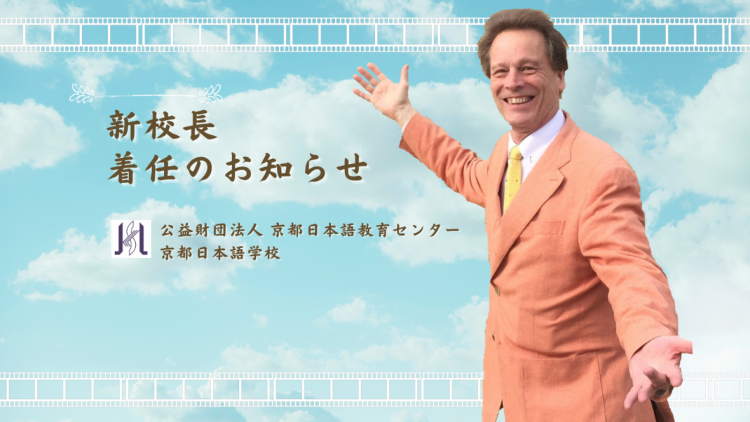2024.10.01
ジェフ バーグランドともうします。これからもどうぞよろしくおねがいいたします。

令和6年8月1日より公益財団法人 京都日本語教育センター 京都日本学校のの校長としてジェフ バーグランドが着任しましたので、お知らせいたします。
---------------------------------------------------------------------------------
ジェフ先生からのメッセージ
こんにちは。私の名前はジェフ・バーグランドです。私はアメリカで生まれ育ちましたが、1969 年に日本語と日本文化を学ぶために来日して以来、京都に住んでいます。京都は、17の世界文化遺産を有する寺社仏閣と伝統文化の宝箱だけではありません。美しい自然、おいしい食べ物、素敵なショッピング、素晴らしいジョギングスポットがあるエキサイティングな現代都市でもあります。
私は京都日本語学校の校長を務めております。70年以上 外国人に日本語と日本文化を教えてきた学校で、外国人がそのような立場にあるのは奇妙だと思われるかもしれませんが、それほど奇妙ではありません。私は 1969 年に KJLS の学生でした。基本的な文法だけでなく、縦社会に欠かせない丁寧な表現や尊敬/謙譲語も学びました。日本は人間関係中心文化です。それが言語にも反映されていると私は思います。また、本や新聞を読むだけでなく、生活に必要な書き言葉も学びました。
私は1969年からこの「京の都」=京都に住んでおり、高校22 年間、大学で 32 年間教壇に立っています。京都が大好きです。京都について 300本 以上のビデオを作成して来ました。「jeff-kyoto.com」や 「Jeff’s Channel」や「jeff@kyotoおもてなし京都観光」で見ることができます。ビデオはそれぞれ 2 ~ 3 分しかありません。私が英語で話しているときは日本語の字幕があり、私が日本語で話しているときは英語の字幕があります。ぜひチェックして、日本語や英語の学習の教材として活用してください。
私の主な研究分野は異文化コミュニケーションです。異文化間 コミュニケーションにおける摩擦の原因の一つは、コミュニケーション スタイルの違いです。コミュニケーションには情報の「発信」と「受信」の両方が含まれるため、文化グループによって「発信者責任型」と「受信者責任型」があります。私がもともと育った米国では「発信力」が重視されます。私が55年間住んでいる日本は世界で最も高度な「受信力」が必要とされます。
ぜひ京都に来て、京都日本語学校で日本語と日本文化、そして日本人のコミュニケーションスタイルを学んでみませんか。
Message to Possible Students
Hello. My name is Jeff Berglund. I was born and brought up in the United States, but I've been living in Kyoto, Japan since 1969 when I came to study Japanese language and culture. Kyoto is not just a city of temples and shrines and traditional culture with 17 World Heritage Sites; it's also an exciting modern city with excellent shopping, delicious food, beautiful nature, and great jogging spots!
I am the principal of the Kyoto Japanese Language School. You might be thinking that it’s strange for a non-Japanese person to be in such a position at a school that has been teaching Japanese language and culture to foreigners for more than 70 years, but it’s not really that strange. I was a student at KJLS in 1969. I learned all the basic grammar as well as the polite expressions and respect/humble language that is so necessary in the Japanese culture of vertical relationships. At the heart of Japanese culture, I believe, is a focus on interpersonal connections, and this focus is reflected in the language. I also learned the written Japanese that is necessary for getting around smoothly as well as for reading a book or newspaper.
I have been living in this “capital of capitals” = Kyoto since 1969, teaching at the high school level for 22 years and at the university level for 32 years. I love this city! I have created more than 300 video clips about Kyoto and you can see these clips on the internet (jeff-kyoto.com, Jeff’s Channel, and jeff@kyotoおもてなし京都観光). The clips are only 2-3 minutes each. When I speak English there are Japanese subtitles and when I speak Japanese there are English subtitles. Please check them out and use them as a source for learning either Japanese or English.
My major field of research is intercultural communication. One possible source of friction in intercultural communication is different communication styles. Since communication involves both the “sending” and “receiving” of information, some cultures stress sending skills (low context) and others stress receiving skills (high context). The United States, where I originally grew up, has a predominately low context “sending” communication culture, whereas Japan, where I have lived for 55 years, has the highest “receiving” communication culture in the world.
I hope that you decide to come to Kyoto and study Japanese language and culture as well as Japanese communication style with us at Kyoto Japanese Language School.